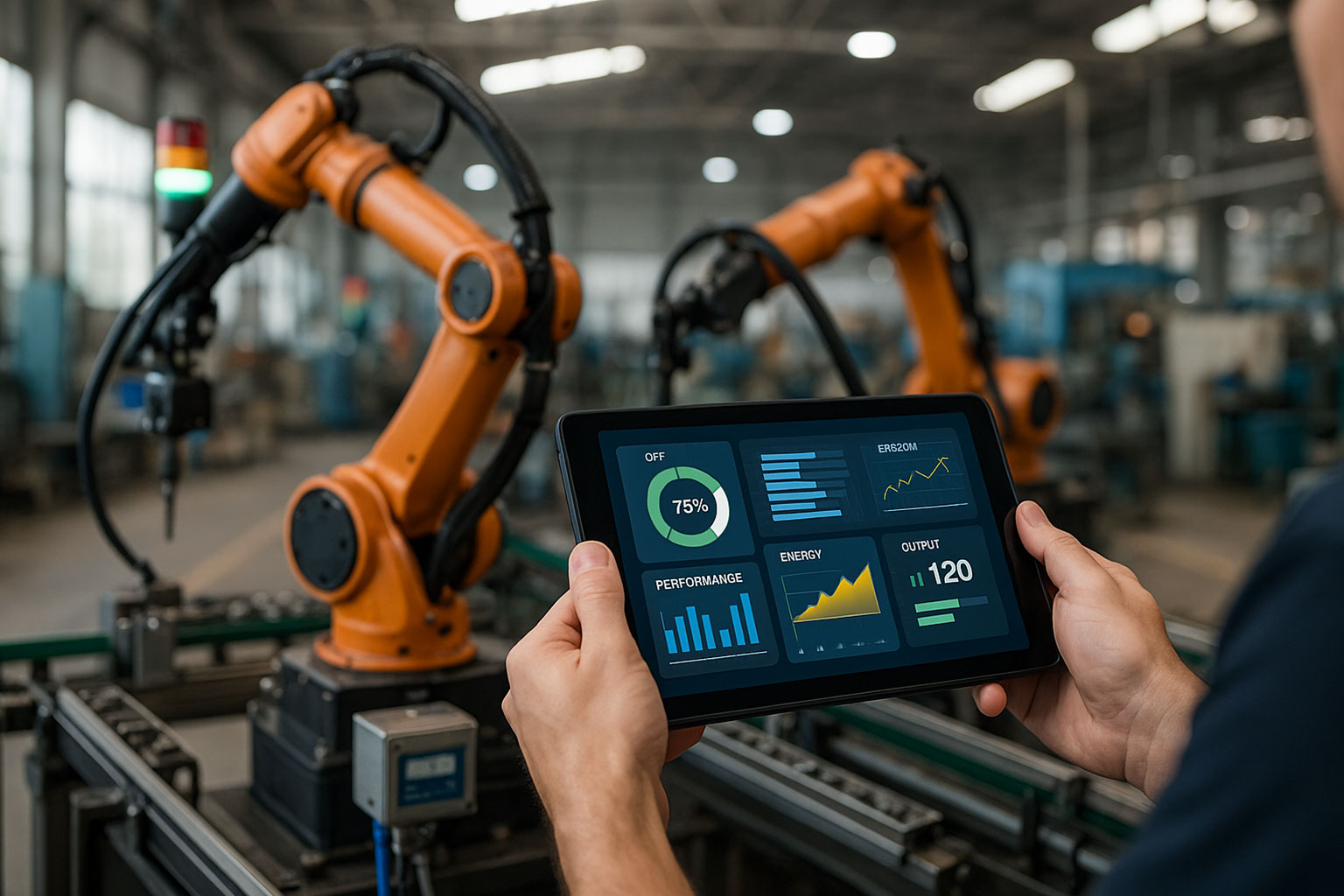Smart Manufacturing with IoT: How Businesses Can Cut Costs & Boost Efficiency

27 Oct 2025
Data, connectivity, and automation are transforming the manufacturing industry in 2025. The world, which used to be dominated by isolated machines has turned into an ecosystem of interconnected thinking, self-adapting and optimizing manufacturing systems. This change is referred to as Smart Manufacturing, and it is supported by the Internet of Things (IoT).
IoT technologies in manufacturing are enabling companies to reduce costs, minimize waste, and maximize output, along with making better decisions and being more sustainable, through predictive maintenance and process automation, real-time analytics, and more.
What Is Smart Manufacturing?
Smart Manufacturing is the combination of IoT, data analytics, cloud computing, and AI with industrial environments. In contrast to the past manufacturing approach, which assumes human control and fixed equipment, smart systems are based on interconnected sensors, IoT gadgets, and real-time data to automate decision-making and improve performance.
Simply put, it is a digital nervous system of factories, where all the machines talk to each other, all the sensors become intelligent, and all the processes become data-oriented.
Key Components of Smart Manufacturing
- Industrial Internet of Things (IIoT): An Interrelated sensor and machine network.
- Cloud Platforms: Centralized storage of data for real-time analytics and visualization.
- AI and Predictive analytics: Determine the patterns to eliminate equipment failure.
- Automation Systems: Smart robotics and control loops for self-adjusting processes.Edge Computing: Fast, localized data processing to reduce latency.
IoT in Production Lines: From Reactive to Predictive
In traditional manufacturing, the maintenance was done on a fixed schedule, not depending on the actual condition of the machines. Unplanned downtime is one of the cost centers in the manufacturing industry, which is one of the largest.
Due to the emergence of IoT factory monitoring systems, the production process has become predictive instead of reactive. Paired sensors are now pursuing parameters such as vibration, temperature and power consumption in real time. In case of irregularities, the system notifies the maintenance teams in time to prevent the occurrence of a failure.
McKinsey (2024) found that the unplanned downtime is minimized by up to 50% and the lifespan of equipment by 20-40 when implemented in factories using an IoT-based predictive maintenance. In the same way, according to the Industrial IoT Benchmark Report by Deloitte, predictive analytics in manufacturing may help enhance efficiency by 15 to 25 percent through early fault identification and optimization of processes.
This is predictive maintenance Internet of Things in action, where real-time data and analytics are used instead of using guesswork, allowing smarter, faster, and cost-effective production lines.
How IoT Reduces Operational Costs
IoT automation of manufacturing does not simply modernize the work process but leads directly to profitability. Here’s how businesses save:
| Cost Area |
Traditional Manufacturing |
With IoT Solutions |
| Maintenance |
Reactive repairs, unexpected downtime |
Predictive alerts prevent breakdowns |
| Energy |
Unmonitored consumption |
Smart meters optimize power usage |
| Labor |
Manual monitoring and reporting |
Automated data collection and alerts |
| Inventory |
Overstocking and waste |
Real-time tracking via IoT sensors |
| Production |
Fixed cycles, inefficiency |
Dynamic optimization using analytics |
This allows manufacturers to detect inefficiencies down to a micro level by linking machines and analytics platforms, which saves costs by 15- 25 percent in the first year of operation.
The Role of IoT Data Analytics in Manufacturing
Data analytics is the actual strength of IoT. Every machine produces thousands of data points in an hour - temperature, vibration, pressure, speed, and output levels. Combined and processed, such data will provide information that allows managers to make decisions based on data.
Key Metrics IoT Data Analytics Can Track:
- Uptime and mean time between failures (MTBF) of equipment.
- Energy saving and carbon footprint.
- Production Yield/shift or operator.
- Quality variations and rate of rejection.
- Machine utilization trends
Using IoT data analytics to monitor the factory, NanoByte Technologies allows clients to view this information in Power BI dashboards, providing them with a real-time view of the health of production regardless of their location.
Predictive Maintenance with IoT: Smarter, Not Harder
One of the largest cost centers in manufacturing is unplanned downtime. One hour of idle time on the machine can result in thousands of wasted outputs.
Predictive algorithms based on real-time data are able to predict failures before they happen through the development of industrial IoT.
For example:
- Vibration anomalies could be a sign of bearing wear.
- Temperature peaks might be an alert of overheating of a motor.
- Existing abnormalities may be indicators of power supply problems.
Rather than responding to a failure, a smart factory is able to achieve the maximum uptime by scheduling maintenance only when necessary, minimizing the number of parts replacements.
Connected Manufacturing Systems: End-to-End Integration
Smart factories are based on networks and not isolated systems. The IoT application creation by NanoByte to factories incorporates all aspects of it, such as shop-floor sensors and enterprise-scale ERP software, to facilitate a smooth flow of data throughout the departments.
Connected Manufacturing Enables:
- Real-time production tracking: Track every production process, starting with raw materials up to finished products.
- Automated quality checks: IoT cameras and sensors indicate deviations in time.
- Supply-chain transparency: Connect vendors, logistics, and warehouse systems on a single platform.
- Remote monitoring of factories: See the performance of the machines via mobile devices.
NanoByte assists businesses by developing interconnected production systems, a system that enables businesses to transcend automation into orchestration.
IoT App Development for Factories: From Prototype to Scale
The creation of a powerful IoT solution needs engineering skills as well as software accuracy. NanoByte Technologies, a leader in the IoT development in the USA, offers end to end services:
Our IoT Manufacturing Development Process:
- Consultation & Use-Case Definition: Finding quantifiable ROI possibilities.
- Hardware and Sensor Integration: Selecting IoT sensors for vibration, energy, or environmental tracking.
- Software Architecture Design: backend and cloud systems.
- IoT Dashboard Development Custom: Development of operations, maintenance, and analytics interfaces.
- Testing & Deployment: Making sure it is accurate, scaled, and cyber-secure.
Supported Platforms:
- Azure IoT Hub
- AWS IoT Core
- Google Cloud IoT
- Custom on-premise solutions for sensitive industries
The engineers of NanoByte make sure that all of the deployments are secure, scalable, and effortlessly blended with your current infrastructure.
Custom IoT Solutions for California Manufacturers
The manufacturing economy of California, including electronics, automotive and food processing, is embracing smart factory software more rapidly than ever. NanoByte Technologies is a California-based company that offers custom IoT solutions that are based on local compliance and environmental standards as well as energy-efficiency objectives.
Use-Cases in the California Industry:
- Food Processing Plants: IoT temperature sensors protect against violations of safety.
- Aerospace Facilities: Real-time torque and vibration monitoring during assembly.
- EV Manufacturing: IoT machine learning production lines through automated testing.
- Textile Industry: Energy saving and humidity regulation to achieve quality output.
Such implementations have allowed our clients to reduce energy consumption by 18 per cent and improve output consistency by 25 per cent.
Benefits of IoT in Manufacturing
- Predictive Maintenance: Minimize downtime and extend equipment life.
- Operational Transparency: Gain full visibility into every process.
- Energy Efficiency: Track and optimize energy use.
- Better Quality Management: Sensor-based monitoring detects defects at an earlier stage.
- Safety in the workplace: Real-time identification of hazards.
- Supply-Chain Optimization: Real-time logistics and inventory.
- Scalability: Add new devices and systems without disruptions.
IoT is not only an investment in technology, but a competitive advantage with the right partner.
Why Choose NanoByte Technologies?
NanoByte Technologies is one of the leading IoT development firms in the U.S. which integrates industry experience with in-depth knowledge in software.
Our Differentiators:
- End-to-End Development: From hardware integration to custom analytics platforms.
- Security-First Approach: Data encryption and device authentication on an industrial level.
- Real-Time Insights: Innovative dashboards with Power BI and Azure Data Factory.
- Custom Engineering: Engineered to fit every manufacturing process no universal fit.
- Cross-Platform Expertise: Azure, AWS, Google Cloud, and private cloud deployments.
They can upgrade a single plant or develop a new network of smart factories, NanoByte IoT developers of manufacturing in the USA can provide reliable, scalable, and ROI-oriented solutions.
The Future of Smart Manufacturing in 2025 and Beyond
It is predicted that over 75 billion of the IoT devices will be connected all over the world by the year 2025 and the majority are set to be produced. In the future, with the development of AI and edge computing, the new frontier of IoT in production lines will address:
- Decision-making independent of humans: Machines correct and adapt themselves to achieve a certain performance goal.
- Sustainable manufacturing: IoT data based on energy and waste minimization.
- Collaborative robotics (Cobots): IoT-enabled robots working safely alongside humans.
- AI-based process management: Self-improving efficiency algorithms.
Automated manufacturing will cease to be a fashion; it will become the standard in the industry.
Conclusion: Turning Factories into Intelligent Ecosystems
The change towards smart manufacturing with IoT is redefining the way businesses are run, compete, and develop.
A connected system, predictive analytics, and real-time insights help companies to reduce costs, increase efficiency, and provide consistent quality never before.
The future of manufacturing is intelligence and not necessarily equipment at NanoByte Technologies.
With our bespoke IoT systems for factories, we assist manufacturers in California and the USA to move away from conventional manufacturing to digital greatness.
When you are willing to modernize your processes, we will create your smart factory.
We are NanoByte Technologies, a top IoT software development company in the USA that has specialized in developing scalable industrial IoT development solutions that help modernize the production process and bring about quantifiable efficiency advantages to every factory floor.





